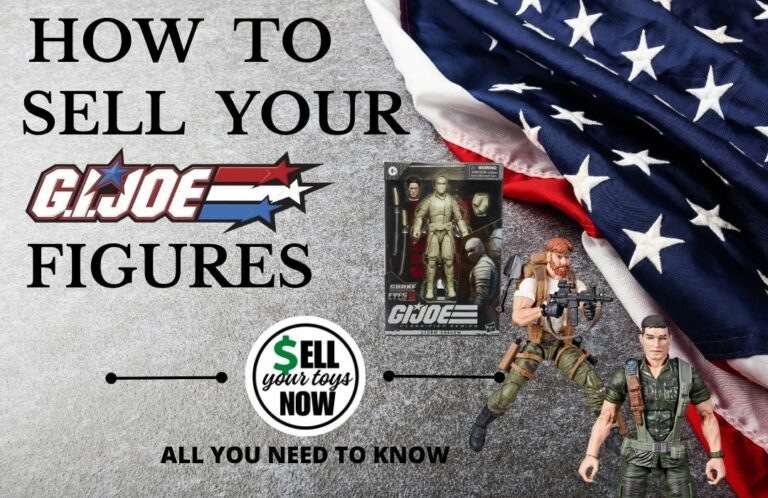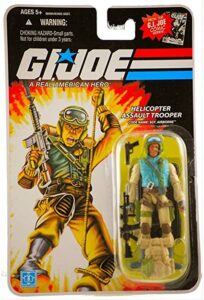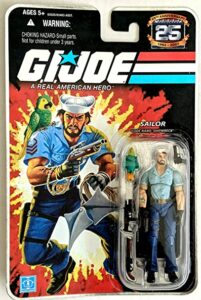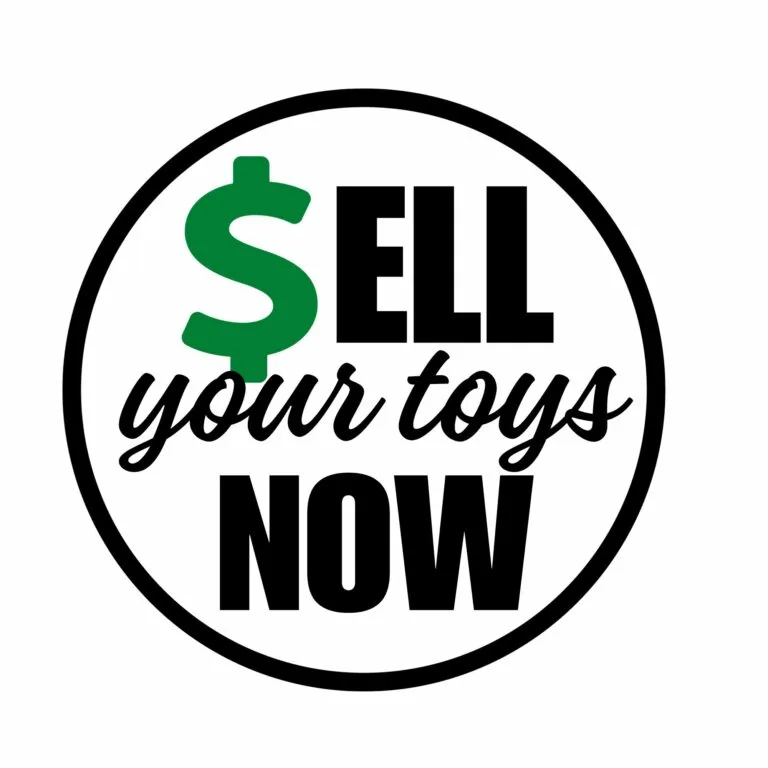How To Sell GI Joe Figures for Top Dollar - All You Need To Know

Selling your GI Joe action figures can enable you to make some spare cash or even fund another collector’s hobby. With GI Joe figures spanning decades and hundreds of unique characters, navigating the resale market takes some strategy. This guide will walk through key tips for efficiently selling your GI Joes at fair prices.
The best way to sell your GI Joes for cash is to identify rare and valuable figures and sell through SellYourToysNow.com for the best rate. Alternatively you can sell through online marketplaces, such as eBay and Facebook marketplace for a lower rate.
Best Place to Sell Your GI Joe Figures
Toy Buyers – SellYourToysNow.com
The best option is selling directly to toy and collectible buyers like us at SellYourToysNow.com. We purchase a wide selection of new and used GI Joes for top dollar. Benefits of selling to toy buyers include:
Free valuation and prepaid shipping – We provide quotes and provide shipping labels for free.
Speed and convenience – Our team handles photography, listings, and sales so you can cash out fast.
Competitive payouts – We pay highly competitive rates based on condition and demand. Rare and vintage sets pay the most.
Direct payouts – Once we receive your toys, payouts are issued quickly, avoiding marketplace payment holds.
By streamlining the entire selling process, you can conveniently liquidate your GI Joe collection for cash with minimal effort.
Sell Your GI Joes at Sell Your Toys Now
At Sell Your Toys Now, we remove the complication from selling your dolls, toys, and action figures. If you have a vintage toy collection in good condition, and you want to earn money from that investment, reach out to our team today.
How To Sell Your GI Joes Fast With Us
Step 1: CONNECT: Let us know what GI Joes you want to sell.
We have many options. You can email, use our app, submit photos, submit a list, or use our toy pricer. This will give us a better idea of what you’re selling.
Step 2: GET A QUOTE: Receive a quote from Sell Your Toys Now.
Within two business days, our staff will evaluate your collection and respond to you with an offer to buy your toy collection.
Step 3: SEND & GET PAID: Ship your collection to receive payment.
If you are satisfied with our quote, you can accept the offer. We will then send you detailed instructions on how to package and ship your items.
We pay for the shipping and provide shipping labels. Once your items are checked in at our warehouse, you should receive payment within 48 hours. We pay via check, Venmo, or PayPal.
Identifying Valuable Figures
When you’re looking to sell GI Joes, the first step is identifying which figures in your collection are most valuable to buyers. This means singling out older, rarer Joes as well as popular and unique characters.
Factors that make a GI Joe figure more desirable include:
Age: Older figures from the 1960s and 1970s tend to be more sought-after by collectors.
Rarity: Figures produced in shorter runs or exclusive editions.
Condition: Excellent condition boxes and instructions sheets increase value.
Characters: Popular characters like Snake Eyes and Storm Shadow or unique characters.
Resources like the GI Joe Collector’s Club and websites of major toy graders can help you identify whether you own any rare or hard-to-find figures. Tapping into collector communities can provide insight into the current market and pricing trends.
Spend time sorting through your collection with an eye for spotting gems hiding amongst more common figures. This will allow you to selectively sell figures likely to drive the most interest and best returns.

Assessing Condition
Once you’ve identified your most valuable Joes, assessing their condition is crucial for accurately pricing them for sale. Collectors will pay much more for figures in excellent condition versus those showing heavy wear.
Important elements to inspect for damage, defects, or missing pieces include:
Figure: Check for cracked, bent, or scratched limbs and uniform details.
Accessories: Confirm all original accessories like weapons are present.
Packaging: Look for crushing, tears, fading, or markings on boxes and inserts.
Additionally, verify backings like cards or inserts have not been replaced. Many collectors focus on high-grade items and complicating factors like restoration can diminish value.
If defects are present, you’ll need to factor the decreased condition into sale pricing accordingly. Having images ready of any damage or wear can proactively address questions from buyers as well.
Researching Pricing
Setting an attractive yet profitable price point for your Joes relies heavily on researching current market rates other sellers are asking for comparable figures.
Helpful pricing resources include:
Our Toy Pricer: See instant quotes from our database to get an immediate price.
eBay Sold Listings: View final selling prices of equivalent Joes to gauge market value.
GI Joe Price Guide: Reference tool showing average values for figures in all conditions.
ComicPriceGuide: Database covering prices for GI Joe comics and collectibles.
Ensure you look up values for the specific character, outfit variant, production year, package version, and condition of your figure. Prices can vary widely even for the exact same Joe depending on these key characteristics.
Browse multiple sources to get a consensus on fair asking prices. Price towards the lower end to stand out amongst competing listings. Consider bracketing highly-desirable items at higher opening bids with best offer options to maximize sale upside.
Listing For Sale Securely
When ready to list your GI Joes for sale, choosing seller-vetted platforms that make your items visible to engaged collectors is key for trustworthy transactions.
Recommended sale avenues include:
eBay: Industry leader for connecting with collectors plus robust seller protections.
Facebook Groups: Highly active collector communities ideal for showcasing rare items.
GI Joe Buy/Sell/Trade Forums: Targeted sites frequented by passionate enthusiasts.
Comic and Toy Showcases: In-person events to showcase items to local buyers.
No matter where you list figures, be sure to include plenty of detailed, high-quality photos showcasing any wear while highlighting accessories and markings that set grails apart.
Accurately and thoroughly filling out item descriptions also builds buyer awareness and confidence during browsing. Proactively addressing condition concerns and provenance details signals reputable selling practices.
Careful Packaging for Shipping
For securing safe shipment of sold Joes, methodical packaging tailored to protect figures, accessories, and boxes from transit damage is paramount for client satisfaction.
Recommended packing best practices include:
Wrap loose figure parts individually then ensemble in bubble wrap.
Pad edges of packaging with added cushioning materials.
Press down box edges and joints with strong tape.
Fill empty voids in boxes with packing paper or air bags to immobilize contents.
Secure exterior shipping box with water-resistant tape for reinforcement.
Go the extra mile adding further waterproofing for overseas or extended duration shipments. Welcome questions from buyers around packaging strategies as this indicates their investment priorities.
While time-consuming, diligent packing greatly minimizes negative experiences like damaged goods or unsecured contents that erode buyer loyalty long-term.
Providing Excellent Service
From listing accuracy through to post-purchase support, striving to provide responsive, thoughtful customer service pays dividends driving referral sales and encouraging repeat buyers.
Helpful service touches include:
Quickly resolving questions: Whether order status, accessory clarification, shipping estimates, etc., prompt replies signal reliability.
Shipping fast: Send off purchases as soon as payments clear. Waiting to batch shipments risks product damage or delays frustrating buyers.
Following up on arrival: Check if special delivery needs were met or if any defects occurred during shipping needing remedy.
Encouraging reviews: If customers seem fully satisfied, politely request they leave positive feedback or ratings to support credibility.
By taking an attentive and consultative approach to supporting buyers throughout and even after transactions, you cement reputation and goodwill yielding added sales. Remember, every interaction is an opportunity to foster community connections between collectors.
Authenticating Rare and Valuable Finds
As you sort through collections and come across what seem like exciting rare discoveries, having a vetting process to authenticate possible gems is critical protection against reselling fakes at unwarranted prices. For nearly every iconic GI Joe, counterfeit figures exist aimed at deceiving impressionable buyers.
Verifying legitness involves cross-checking telling details, ideally with the support of certification authorities. Areas to inspect closely include:
Mold Markings: Subtly stamped model numbers, company initials, and dates signatures molded correctly correlate to genuine molds. Fakes often misplace or omit these marks.
Fabrics: Pattern alignments and material quality for uniforms should match era-appropriate designs on file cards down to fibers and dying techniques resistant to fading.
Finishings: Custom stamps, logos placement, helmet interior paddings, and rivet consistency authenticate master molds rather than inferior copies.
Accessories: Correct shapes, scaled proportions, branded logos can confirm real licensed kit accessories rather than imitation props and weapons.
Leverage resources like collector forums, historian write-ups, toy grader blogs, and the GI Joe Collectors Club magazine to drill down on release-specific manufacturing details. If still uncertain, consider having reputable authenticators like GAMA professionally validate items prior to purchasing or sales listings. While fees apply, authentication reports protect against good faith deals gone wrong.
Guarding against reselling forged items with false backstories protects the integrity of the hobby. Remember as well, authentic high demand items often move quickly through experienced circles at premiums, making deals that seem too good to be true rightly suspicious.

Parting Out Less Popular Figures
While your first instinct may be to keep all accessories, uniforms, and tools together as intact figures, consider parting out less popular figures into individually sold customization elements.
Repurposing common figure elements like uniforms or niche tools across more highly demanded characters actually appeals to customizers seeking to unlock new character designs. Additionally, prices for kits shipped in bulk deliver lower margins, so breaking apart niche elements into smaller speciality auctions creates opportunities for improved returns.
Ideal part out candidates include:
Obscure figures: Parts have higher value than incomplete figures which collectors may not pursue.
Damaged figures: Parting lets you sell elements still appealing, like weapons or uniforms, from figures where damage significantly hurts value.
Extra accessories: Parting out surplus gear from vehicle sets or multiple lots avoids accessories getting stranded if figures sell first.
List item specifics like mold markings in titles and highlight gear’s customization potential in descriptions to attract modder interest. Consider bundled discounts around thematically linked accessories while pricing higher demand kits like medical and communications gear more aggressively.
Also develop shipping strategies around safely sending loose, small items cost effectively. Approaches like envelopes with cardboard reinforcements secure delicate accessories like radio headsets during mail handlings while minimizing costs versus boxes.
Consigning Rare Items to Auction
While direct sales provide full autonomy, expanding your selling channels to include consignment auction houses exposes prized items from your collection to networks of qualified global buyers accustomed to paying premiums for elite graded collectibles.
Heritage Auctions receives consistently high praise from GI Joe enthusiasts for driving record sales through its occasional dedicated GI Joe catalog auctions, not to mention heavy promotion driving collector awareness.
Other reputable houses facilitating rare toy transactions include Sotheby’s, Bonhams, Bertoia Auctions, and Julien’s Auctions, to name a few. While broader collector car, art, and antiquities auctioneers may occasionally feature high grade toy lots as well when sourced by toy specialists.
Consignment tips for maximizing returns include:
Have items professionally appraised beforehand to set fair reserve pricing.
Schedule consignments to align with major collector conventions drawing media coverage.
Stipulate auction house promotions like specialty catalog placements and social campaigns.
Take advantage of investor financing options some houses offer during waiting periods for top items.
While you will lose a portion of hammer prices to buyer premiums and seller commissions, the exponential buyer reach and competition consignments stir can drive exponential end prices even after fees.
Just be sure to focus on your most elite Holy Grail figures worth the added logistics of consigning locally versus direct sales.
Connecting with Fellow Enthusiasts
Beyond building your bankroll, an added benefit of regularly dealing vintage GI Joes is forging connections with fellow toy collectors sharing your interests and passion. As the saying goes, it takes one to know one.
Upon spotting fellow enthusiasts at conventions, auctions, trade events, or even contacting prolific buyers or sellers you’ve come to notice across marketplaces, consider reaching out for informal chats.
Ice breakers like asking about focusing their particular collection story or proudly showing off your newest acquisition builds quick camaraderie around mutual joys. You might even discover you share geographic or professional overlaps kindling deeper networking.
Over time, such organic interactions mature into trusted relationships paying collaborative dividends:
Priority access – dealers may offer early purchase opportunities for high demand items they source to proven contacts first.
Market intelligence – collector friends keep ears open about grail pieces becoming available to flag you on.
Price guidance – other traders provide comp pricing context before major buys or sales.
Referrals – strong informal networks shuffle opportunities and connections.
Sustaining open, friendly collector ties ultimately enriches the overall collecting lifestyle beyond just transactional gains. Never underestimate the social rewards of connecting around common interests either in-person or virtually.
Conclusion
Selling GI Joes requires equal parts passion and diligence. But armed with an understanding of identifying grail figures, assessing condition thoughtfully, setting market-aligned pricing, listing securely online, packaging items meticulously, and delivering excellent service, you gain a blueprint for repeatedly translating your collection into consistent sales.
Lean on collector communities to gain insights into ever-evolving trends around desirable characters, prototypical packaging, emerging accessories, and finer condition details that unlock premium valuations. Getting connected with fellow enthusiasts also opens up horizons for profitable buying, selling, and trading opportunities.
Fundamentally, approach sales through a collector’s mindset. This ensures you handle prized items with the care they warrant while supporting fellow hobbyists in continuing the enjoyment these iconic toys have delivered for decades. In preserving others’ experiences, you ultimately enhance and fund your own as well.
Frequently Asked Questions
What are the most valuable GI Joe figures to sell?
Some of the most valuable vintage GI Joe figures that tend to drive top dollar in the resale marketplace include the 1960s talking figures, 12-inch figures from the Adventure Team series, early prototype designs, foreign exclusive variants, vehicles and playsets in fully assembled condition, as well as complete collections from original owners.
What defects most negatively impact a figure’s value?
Figure damage like visible cracks, missing or broken appendages, torn clothing, scrubbed off or faded original paint markings, and replaced parts negatively affect value. For carded figures, creased bubbles, ripped, stained or marked backing cards, and missing file cards also lower price. Anything detracting from a figure’s collector grade lowers appeal.
How do I ship loose vintage GI Joe figures safely?
The best practice is to individually wrap accessories and figure parts in small plastic bags first. Then bundle the full figure group together snugly in a larger bag filled with packing paper or bubble wrap. Pack this secured bundle centered in a sturdy box filled with ample packing material. Waterproof and reinforce the outer shipping box.
What information should I include in listings?
Important details to cover include identifying the exact name and style of the figure, release year, unique body mold numbers, accessory names and quantities, condition summaries of any defects or damage, an honest appraisal of restoration presence if applicable, photos from multiple angles, and manufacturing, country of origin, and packaging specifics.
How do I resolve issues if a figure arrives damaged?
If a customer contacts you about damage incurred during shipping, apologize and request photos of the damage to assess next steps. If it is reasonable that it occurred during transit, offer to refund the full purchase amount or provide replacement figures to make it right based on the buyer’s preference. In some cases reimbursement for restoration or conservation may also be warranted.
